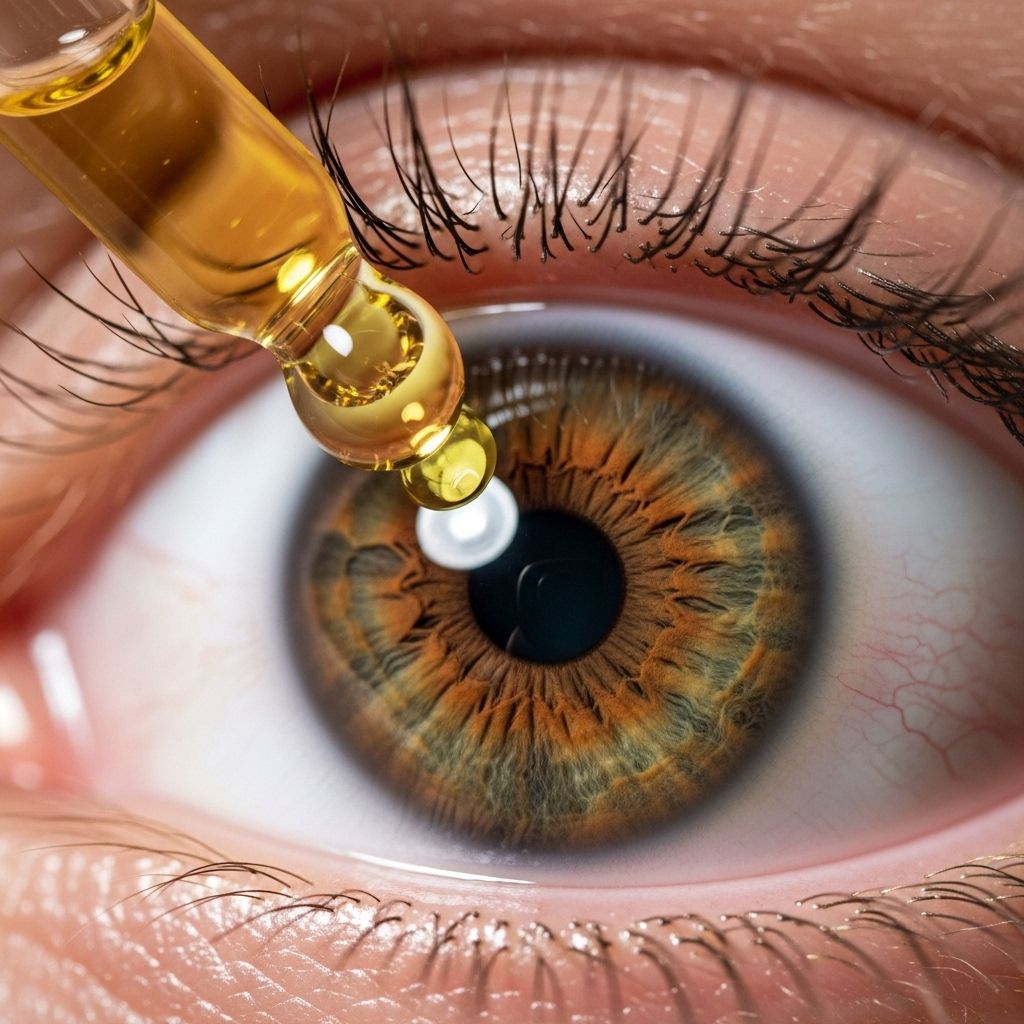Castor Oil For Eyes: Uses, Benefits, Side Effects, And Application Guide
Seals in hydration to relieve dryness and calm eyelid sensitivity.

Castor oil, derived from the seeds of the Ricinus communis plant, has been traditionally used as a natural remedy for a variety of ailments and cosmetic concerns. In recent years, it has found its place in holistic and clinical approaches to eye health, particularly for its moisturizing and anti-inflammatory properties. This article delves into the potential advantages, scientific evidence, uses, side effects, and safe ways to use castor oil for the eyes and surrounding areas.
What Is Castor Oil?
Castor oil is a clear to pale yellow vegetable oil obtained by cold pressing castor beans. It is renowned for its high concentration of ricinoleic acid, a unique fatty acid that imparts significant anti-inflammatory and antimicrobial properties. Traditionally, castor oil has been used in cosmetics, medicine, and industry, and more recently, its role in eye care has been explored in both research and home remedies.
The oil is primarily harvested in Africa, South America, and India, with India contributing the majority of the world’s supply.
How Does Castor Oil Benefit Eye Health?
The application of castor oil in eye care is based on its ability to:
- Moisturize the eyes and eyelids, reducing symptoms of dryness
- Stabilize the tear film lipid layer, thus minimizing tear evaporation and improving eye comfort
- Possess anti-inflammatory and antimicrobial properties that may alleviate irritation and support general eye and eyelid health
- Improve Meibomian Gland Dysfunction (MGD), a leading cause of evaporative dry eye disease
- Aid in periocular skin care, possibly helping with puffiness, dark circles, and wrinkles when used with caution
Key Benefits Supported by Research
- Reduces Dry Eyes: Eye drops containing castor oil have been found to reduce symptoms of dry eyes by thickening the lipid layer of the tear film, thereby reducing water evaporation from the ocular surface.
- Improves Tear Film Stability: A stable tear film is crucial for persistent ocular comfort. Studies show that castor oil in artificial tears enhances the lipid layer’s function, promoting better eye hydration.
- Alleviates Inflammation and Discomfort: Ricinoleic acid within castor oil exhibits anti-inflammatory actions. This helps ease redness, irritation, and mild forms of eyelid inflammation such as blepharitis.
- Prolonged Relief: Due to its viscosity, castor oil remains on the eye for an extended period (up to several hours), often outlasting standard eye drops.
Common Uses Of Castor Oil For Eyes
Many people explore castor oil for the following eye-related purposes. Please note that medical guidance is recommended before starting any new treatment, especially for eye care.
| Application | Potential Benefit |
|---|---|
| Relieving dry eyes | Increases moisture and reduces tear evaporation |
| Improving meibomian gland dysfunction (MGD) | Helps unclog oil glands, improves tear film lipid layer |
| Reducing under-eye puffiness | Soothes and moisturizes skin, potentially reducing bags |
| Minimizing dark circles | Improves skin hydration and may decrease pigmentation appearance |
| Aiding in blepharitis management | Antimicrobial and anti-inflammatory properties help soothe inflamed eyelids |
| Soothing eye irritation | Anti-inflammatory effects ease mild redness and discomfort |
| Helping with eyelash and eyebrow growth | When applied carefully, may condition hairs and support healthier lashes and brows |
How Does Castor Oil Work On Eyes?
Castor oil works via several mechanisms:
- Forms a Lipid Barrier: The oil creates a film that locks in moisture, which is especially important for those with dry eyes.
- Supports Tear Film: By thickening the lipid layer, castor oil reduces evaporation, helping the eyes remain hydrated between blinks.
- Anti-Inflammatory Action: Ricinoleic acid calms inflammation on the eye surface and surrounding skin.
- Microbial Defense: Certain compounds in castor oil exhibit antimicrobial activity, potentially limiting growth of organisms contributing to eyelid irritation and blepharitis.
Types Of Castor Oil Used For Eye Health
Several forms of castor oil are considered for eye and eyelid care:
- Sterile Castor Oil Eye Drops: Specially formulated for ocular use, these are often available over-the-counter or in prescription artificial tears. They are emulsified for better mixing with tears and are made under stringent sterile conditions for safety.
- Topical Castor Oil (for lids and skin): Typically cold-pressed and packaged to maintain purity. While applied to skin and eyelids, these should NOT be directly applied to the eye itself unless the label specifically states ocular safety.
- Regular (non-sterile) Castor Oil: Available in beauty and pharmacy stores, but not recommended for direct eye use due to sterility concerns.
Safe Application: How To Use Castor Oil For Eyes
For those wishing to try castor oil for eye or eyelid health, meticulous hygiene and product choice are vital. Only use products labeled for ophthalmic or eye use for direct application to the eyes.
Using Castor Oil Eye Drops
- Wash your hands thoroughly before touching your face and eyes.
- If using drops, shake the bottle (if an emulsion) as per product instructions.
- Tilt your head back, gently pull down your lower eyelid, and squeeze one drop into the pocket formed by your lower lid.
- Close your eye gently. Do not rub. Let the drop disperse naturally.
- Blink a few times to help spread the oil along your eye surface.
- Repeat as directed. Do not exceed the recommended dosage.
Applying Castor Oil To Eyelids Or Eyelashes
- Use a cotton swab or clean fingertip.
- Dab a minute amount of cold-pressed (and ideally sterile) castor oil along the eyelid margin, staying outside the lash line to avoid direct contact with the eye.
- Apply at night (optional), and gently clean in the morning if residue remains.
- Never use castor oil in the eye unless it is sterilized and clearly labeled for ophthalmic use.
Potential Side Effects And Precautions
While generally well-tolerated for most topical and ocular applications, castor oil can cause adverse reactions in sensitive individuals or when used improperly:
- Blurry vision (usually temporary and resolves within minutes to hours)
- Eye redness, itching, or burning—possible allergic reaction
- Swelling of the eyelids or skin
- Other allergy symptoms: trouble breathing, dizziness, or nausea
If any serious or persistent symptoms occur, stop use immediately and contact a healthcare provider. Eye infections can occur if non-sterile oil is applied, so sterility is essential.
When Not To Use Castor Oil For Eyes
- You have a known allergy to castor beans or castor oil
- You have ongoing eye infection or recent eye surgery (consult doctor first)
- You lack access to sterile, ophthalmic-grade castor oil
Children, contact lens users, and those with chronic eye diseases should consult an eye care provider before use.
Scientific Evidence: What Does the Research Say?
- Lipid-Based Artificial Tears: Multiple studies have shown that lipid-based artificial tears, including those with castor oil, improve symptoms and objective measurements of dry eye, especially in those with MGD and evaporative dry eye.
- Eyelid & Periocular Health: Castor oil has been used topically on the eyelids to improve skin condition and relieve symptoms of blepharitis (eyelid inflammation), as its antimicrobial properties may combat lid margin bacteria.
- Duration: Castor oil’s thicker consistency leads to longer retention time on the ocular surface—beneficial for overnight lubrication.
Despite numerous anecdotal reports, robust large-scale clinical trials are still limited, so medical guidance remains advisable.
Castor Oil For Dark Circles, Puffiness, And Wrinkles: Myth Or Fact?
Many beauty enthusiasts promote castor oil as a remedy for dark circles, puffy eyes, and even wrinkles. Here’s what is currently understood:
- Moisturizing Effect: Castor oil deeply hydrates the delicate under-eye skin, which may make dark circles and fine lines less noticeable.
- Reduction in Puffiness: The anti-inflammatory components may soothe swelling.
- No Direct Evidence: There is currently limited or inconclusive clinical research showing that castor oil cures dark circles or dramatically reverses wrinkles, but it does support under-eye hydration and softness.
Results can be modest and vary from person to person.
Popular Eye Drop Brands That Contain Castor Oil
- Refresh Optive Mega-3
- Blink Triple Care
- Restasis (prescription)
- Cequa (prescription)
These eye drops combine castor oil with other ingredients for enhanced lubrication and ocular surface stability. Customers should choose only those products specifically formulated for eye use to ensure safety.
Tips For Safe And Effective Castor Oil Application
- Always choose sterile, hexane-free, cold-pressed castor oil for any skin or eyelid use.
- Do a patch test on your inner arm before using it near your eyes.
- For direct intraocular application, use only commercial products labeled “for eye use.”
- Never share eye drops or applicators with others.
- Consult an eye doctor if you experience pain, persistent irritation, or vision changes.
Frequently Asked Questions (FAQs)
Is castor oil safe to put directly in the eyes?
Only sterile, ophthalmic-grade castor oil eye drops should be used for direct application inside the eyes. Household or regular beauty-grade castor oil should NOT be applied to the eye itself due to sterility concerns.
Can castor oil help with eye floaters or cataracts?
There is no clinical evidence that castor oil can dissolve floaters or reverse cataracts. Its primary benefit is for lubrication and eyelid skin health, not internal eye diseases.
How often can I use castor oil eye drops?
Frequency depends on the specific product and manufacturer’s instructions. Generally, 1-2 drops up to several times daily is common, but always follow package directions or your doctor’s advice.
Will castor oil improve eyelash or eyebrow growth?
Topical castor oil can condition and support healthy hairs, but robust scientific support for dramatic growth is lacking. It can, nonetheless, add shine and help prevent breakage when used judiciously.
What should I do if I develop irritation after using castor oil?
Discontinue use immediately and rinse the area gently with clean water. If symptoms persist or worsen (e.g., swelling, vision changes), contact your healthcare provider promptly.
Final Thoughts
Castor oil has a long history of safe cosmetic and medicinal use and shows promise as a supportive component in the treatment of dry eyes, eyelid conditions, and periocular skin care. For best results and to avoid complications, opt for products specifically intended for ocular use, maintain strict hygiene, and consult your ophthalmologist before starting any new eye care regimen.
References
- https://www.webmd.com/eye-health/health-benefits-of-castor-oil-eye-drops
- https://www.youtube.com/watch?v=RuvyCYpVOvM
- https://eyesoneyecare.com/resources/castor-oil-and-eyes-good-bad-and-dangerous/
- https://www.healthline.com/health/castor-oil-for-dry-eyes
- https://www.news-medical.net/news/20240202/New-trial-explores-cold-pressed-castor-oil-as-safe-natural-treatment-for-dry-eye-disease.aspx
- https://www.ucihealth.org/about-us/news/2023/08/castor-oil
- https://www.healthline.com/health/castor-oil-for-dark-circles
- https://www.medicalnewstoday.com/articles/castor-oil-potential-natural-treatment-dry-eye-disease
Read full bio of Sneha Tete













